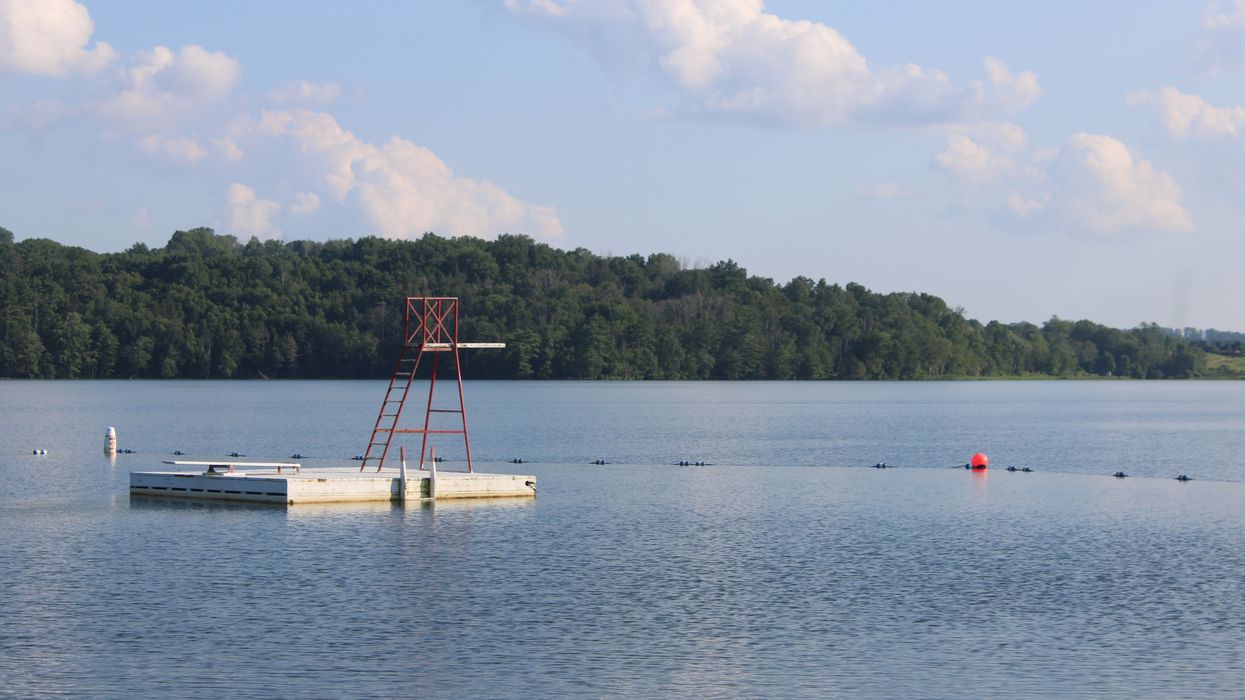‘Internal loading’ a major concern for Mudge Pond

Sharon’s Mudge Pond spans more than 200 acres.
Alec Linden

Sharon’s Mudge Pond spans more than 200 acres.
SHARON — A new report prepared by the Northwest Conservation District found it’s not only recent agricultural runoff that impacts the water quality of Mudge Pond, but pollution from bygone farms of decades ago.
The reason for this is a process called “internal loading,” stated the report, which was prepared by NWCD Natural Resource Specialist Kelsey Sudol and presented to the Board of Selectmen at its August 26 meeting by selectwoman Lynn Kearcher. Drawing from the findings of a February 2025 study (researched in 2024) by environmental consultancy Northeast Aquatic Research, Sudol’s memo declares that “internal loading is the main major water quality concern for Mudge Pond currently.”
Internal loading is the release of harmful particulates that were once entombed in the lake bottom back into the water column. It results from a layer of anoxic or hypoxic — water either entirely or almost entirely devoid of dissolved oxygen – sitting on the lake bottom for longer than usual.
It’s normal for this to happen for a period in New England’s freshwater lakes during the summer when they’re “stratified” (i.e. when warmer, less dense water sits above cooler, denser water). In this state, the layers don’t mix and the deeper water is unable to receive additional oxygen from the well-oxygenated layers above.
Warmer winters, however, can cause this process to begin earlier, especially with a shortened ice season. These extended anoxic periods, which were confirmed by several readings taken during the Northeast Aquatic Research study, allow harmful pollutants that may have been sitting on the lake bottom for decades to reappear and cause damage. Nitrogen and especially phosphorus are two such products of historic agricultural runoff that pose a risk to Mudge Pond.
The NWCD report upholds that “within watersheds that have a long history of agriculture, which Mudge Pond does, this release of historic pollution is common.” There is an urgency to remedying this issue, the report went on, given that “the stressors that are worsening this internal loading, like warmer winters, are not projected to improve.”
The report recommends aeration, a technology which artificially inputs oxygen into deeper water, as the most promising remediation tactic. The suggestion follows the Northeast Aquatic Research study which declared that “the lake is an excellent candidate for artificial aeration.” Northeast Aquatic Research would not suggest a specific method by which to implement the solution, however, until it had completed further research, stating the group would be able to present “state-of-the-art” options to the town by the spring of 2026.
Neither the town nor the Mudge Pond Association — the lake’s newly-formed recreation and protection authority — have stated whether an aeration solution will be pursued, although the Association has indicated a commitment to weigh all possible protective measures.
While the reappearance of old pollutants presents the greatest water quality risk, current runoff also poses a threat. The Northeast Aquatic Research report located a high concentration of nitrogen at certain times of the year near an inlet that enters the lake on its eastern shore, downslope from Low Road. The feeder streams flow through a wetland before reaching the lake at the inlet, which is a cause for concern as wetlands usually act as “biofilters” that remove nutrients from the water, stated Northeast Aquatic Research.
The NWCD offered to conduct a stream-walk to locate the sources of these nutrients that would help develop a “watershed monitoring program.” The group would also help the town educate property owners and farmers within the watershed on erosion control and nutrient runoff management. Such practices have worked before, the NWCD correspondence stated: according to historic reports from 1999, 2000 and 2001, once newly-established best management practices were adopted in area farms in the 1980s and 1990s, Mudge Pond’s water quality drastically improved.
The NWCD also offered to conduct a volunteer event to remove invasive water chestnut, sending out flotillas of kayakers to hand-pull the water weed in a minimally invasive procedure. Earlier in the summer, an effort by the Mudge Pond Association and local consultancy New England Aquatic Services to hand-pull the plant was stymied by a much-greater amount of organic material than anticipated. A bigger team could help, the NWCD recommended in the memo.
The Mudge Pond Association said it is carefully weighing NWCD’s many suggestions, and is working on next steps.
The Salisbury Winter Sports Association (SWSA) will host its annual Junior Jump Camp, a two-day introduction to ski jumping, on Saturday and Sunday, Dec. 27 and 28, from 9 a.m. to 2 p.m. at Satre Hill in Salisbury.
The camp is open to children ages 7 and up and focuses on teaching the basics of ski jumping, with an emphasis on safety, balance and control, using SWSA’s smallest hill. No prior experience is required.
The cost is $50 per child and includes instruction and lunch on both days. For more information or to register, visit www.skireg.com/swsa-camp or email info@jumpfest.org
Jesse Bunce, first selectman of North Canaan.
LITCHFIELD — The Northwest Hills Council of Governments welcomed six newly elected municipal leaders Thursday, Dec. 11, at its first meeting following the 2025 municipal elections.
The council — a regional planning body representing 21 towns in northwest Connecticut — coordinates transportation, emergency planning, housing, economic development and other shared municipal services.
Barkhamsted First Selectman Meaghan Cook, Goshen First Selectman Seth Breakell, Kent First Selectman Eric Epstein, Norfolk First Selectman Henry Tirrell, North Canaan First Selectman Jesse Bunce and Torrington Mayor Molly Spino were each elected to their post in November.
They filled the seats of their predecessors on the COG, who were each given a toast of appreciation: Nick Lukiwsky (Barkhamsted), Todd Carusillo (Goshen), Marty Lindenmeyer (Kent), Matt Riiska (Norfolk), Brian Ohler (North Canaan) and Elinor Carbone (Torrington).
COG Executive Director Rob Phillips said the outgoing members were given a going away mug that read “You’re living the dream still.” Members voted to appoint Warren First Selectman Greg LaCava to fill a vacancy on the Council’s Executive Committee. COG members voted by paper ballot, and LaCava defeated Burlington First Selectman Doug Thompson for the vacant seat.
Ryan Segalla takes a fadeaway shot over a defender.
FALLS VILLAGE — Housatonic Valley Regional High School’s boys basketball team defeated Pine Plains High School 60-22 in a scrimmage Tuesday, Dec. 9. The non-league preseason game gave both sides an opportunity to run the court ahead of the 2025-26 varsity season.
HVRHS’s senior-heavy roster played with power and poise. The boys pulled ahead early and kept their foot on the gas through to the end.
By halftime the score was 33-8. Junior varsity players subbed in for the second half, but not before the starters got some in-game dunk practice. By the end Housatonic totaled 60 points to Pine Plains’ 22.

Nick Crodelle led the Mountaineers offensively with 13 points. Anthony Labbadia and Wyatt Bayer scored nine points each. Anthony Foley scored eight points. Owen Riemer and Ryan Segalla each scored seven points. Peyton Bushnell hit a three-pointer. Jaxon Visockis and Henry Berry each scored two points.
HVRHS begins Berkshire League competition on the road at Nonnewaug High School Tuesday, Dec. 16, with a 6 p.m. tip off.


Katie Moore delivers toys to the Stuff a Truck campaign held by the Kent Volunteer Fire Department last weekend. Donated toys are collected so that parents, who need some assistance, may provide their children with gifts this Christmas. Accepting the donation are elves Fran Goodsell and Karen Iannucci
KENT — Santa’s elves were toasty warm as they collected toys for the children of Kent.
Keeping with annual tradition, Fran Goodsell and Karen Iannucci manned the Stuff a Truck campaign sponsored by the Kent Volunteer Fire Department on Saturday, Dec. 6, and Sunday, Dec. 7. Sitting in front of a fire pit in the firehouse parking lot between donations from residents, they spoke of the incredible generosity displayed every season. That spirit of giving was clear from the piles of toys heaped on a table.
“This is always so gratifying,” said Goodsell, noting that certain businesses, including High Watch Recovery Center, Wilson’s, and Kent and South Kent schools needed a “shout out” for all they’ve done. She said South Kent School focuses on gifts for older children, which is a group that often is overlooked.
Unwrapped contributions are sought for children 1 to 15 years old who might otherwise find little or nothing from Santa, they said. The bounty will be set up at the Community House on Thursday, allowing parents to come and take what they want. If there are still items left, grandparents are invited to “shop.”
The atmosphere was festive Saturday, as a stuffed dog began barking a Christmas tune whenever someone walked in front of it. A large decked-out bear posted at the parking lot entrance reminded passersby of the event. Visiting children were able to get a close-up look at the fire truck and walk through the firehouse if they wished.
Goodsell and Iannucci were very grateful to those who donated wood for the fire pit. “And so many asked if they could bring us coffee or hot chocolate,” said Iannucci.
Goodsell said many who came talked about having grown children who were recipients of the gifts when their families were struggling. “They are so glad to be able to give back,” she said.